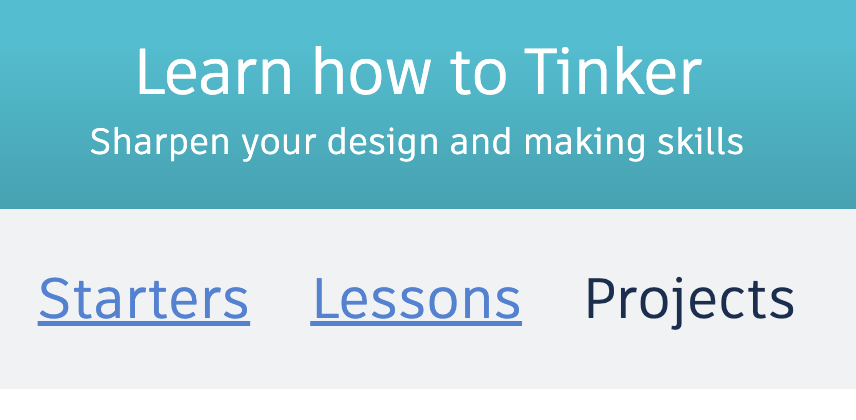
Tinkercad

Overview
Tinkercad is a free online application that quickly allows students to virtually design three-dimensional objects and create files for 3D printing. A 3D printer is not required, although without printing projects will remain in the virtual realm. There are step-by-step lessons and projects available at no cost. Tinkercad has an option where teachers may send out an invite code for ease in setting up student accounts along with the ability to moderate students under 13. No experience necessary! You may learn how to use this program by completing guided tutorials.
Learning Objectives
Students will:
- Understand how to use a computer-assisted design application to design and create three-dimensional projects.
- Be able to evaluate designs by utilizing feedback provided by a computer-assisted instruction application and use this feedback to make revisions as needed.
- Be able to create innovative artifacts using a deliberate design process.
Vocabulary
Vocabulary Words:
- Innovative Artifact: An innovative artifact is an original project using a technology tool that is created to share information in a creative manner.
- Design Process: The design process is a step-by-step design process that helps one to generate ideas, test them, and solve problems.
- Digital Tools: The use of digital tools, such as computer-assisted design software, to create an artifact.
- Computer-Assisted Design (CAD): The use of computer systems (or workstations) to aid in the creation, modification, analysis, or optimization of a design
- Computer-Assisted Instruction (CAI): CAI is a program of instructional material presented by means of a computer or computer systems.
- Prototype: A prototype is the project draft that will be shared and shown for feedback for improvement.
- Scale: A scale is the relative size of something.
- Rotate: To rotate is to move or cause to move in a circle around an axis or center.
- Shortcuts: Shortcuts are a quick way to use your keyboard using a series of two-three keys.
- Ctrl c- copy
- Ctrl v- paste
- Ctrl z- undo
Pre-planning
To prepare for this activity:
-
View this how-to video for a quick overview of what Tinkercad can do and how to use it.
-
Set up student accounts. Tinkercad has an option where an invite code may be distributed for ease of setup along with the ability to moderate students under 13.
-
Review creations in the Gallery.
-
Once logged in, students and teachers can view and access Starters, Lessons, and Projects.

-
There are step-by-step instructions to learn how to do the various projects.
-
-
Here is a step-by-step lesson from Mrs. Paxton showing how to 3d print a keychain.
Accommodations
See the Accommodations Page and Charts on the 21things4students website in the Teacher Resources.
Steps
Directions for this activity:
- Students login to their accounts.
- The teacher is also logged in to model steps.
- The teacher introduces what Tinkercad is, and explains what computer-assisted design programs do.
- Optionally, you can show them the nine-minute video so they have an idea of what Tinkercad is and what it can do.
- Provide a few examples of use, such as creating prosthetic arms, hooks for use in the classroom, etc.
- Begin the first basic tutorial modeling step-by-step. Explain to students that the directions are written in the left navigation panel. Alternate modeling steps with students completing them.
- The first four basic lessons may be completed in one session.
- Learning the Moves
- Camera Controls
- Creating Holes
- Scale Copy and Paste
Optional Activity: The last two basics are quite useful, but will extend beyond a 20-minute session. It is recommended that these two tutorials are completed prior to beginning the projects that are offered on the site. Once the series of lessons are completed students will also be ready to complete independent projects.
NOTE: If you are interested in printing projects, but do not have access to a printer check with your local ISD. Additionally, there are online vendors who will print projects for a fee.
Assessment Options
Different options for assessing the students:
- Observations
- Check for understanding
- The Tinkercad tutorials are designed with built-in feedback for students.
- Students may submit a screenshot of each lesson demonstrating mastery to the teacher if desired.
MITECS COMPETENCIES & ISTE STANDARDS
MITECS: Michigan adopted the "ISTE Standards for Students" called MITECS (Michigan Integrated Technology Competencies for Students) in 2018.
Innovative Designer
4a. Students know and use a deliberate design process for generating ideas, testing theories, creating innovative artifacts or solving authentic problems.
4b. Students select and use digital tools to plan and manage a design process that considers design constraints and calculated risks.
4c. Students develop, test and refine prototypes as part of a cyclical design process.
4d. Students exhibit a tolerance for ambiguity, perseverance and the capacity to work with open-ended problems.
Devices and Resources
Device: PC, Chromebook, Mac, iPad
Browser: Chrome, Safari, Firefox, Edge, ALL
Websites:
3D Keychain Printing Project
Tinkercad
TinkerCAD - Tutorial for Beginners in 9 MINUTES! [ 2021 - COMPLETE ]
CONTENT AREA RESOURCES
Math
-
4.MD.1 Students design and create objects and use these to understand the relative sizes of mm and cm.
-
Students will express cm in terms of mm (for example, 3.2 cm is 32 mm). Students may notate in a conversion table the dimensions of the object(s) showing cm and mm.
Science
- P.EN.04.51 Demonstrate how electrical energy is transferred and changed through the use of a simple circuit by building and adapting circuits on Tinkercad. See the Circuits tab in the Learn section for circuits basics and projects.
- 3-5 ETS-1-1 and 3-5 ETS-1-2 Design a keychain utilizing the engineering design process meeting specified criteria and constraints.
Social Studies
4.G2.01 Describe ways in which the United States can be divided into different regions by designing models of different regions using Tinkercad.
Credits
This task card was created by Patricia Paxton, Armada Area Schools, February 2018. Updated November 2023.


